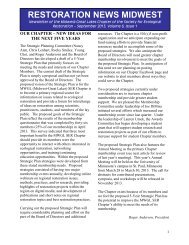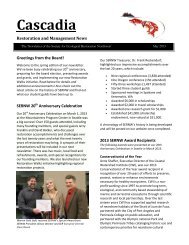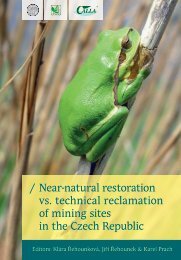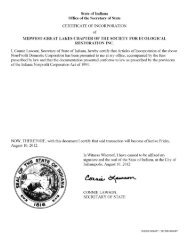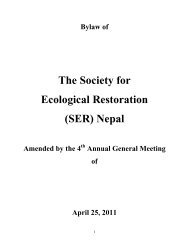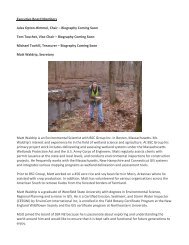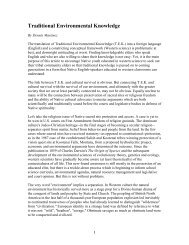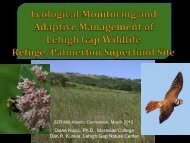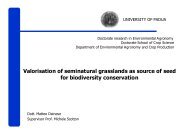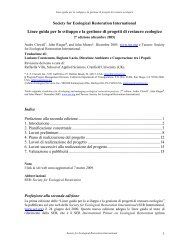THE WORLD CONFERENCE ON ECOLOGICAL RESTORATION
A Global Challenge - Society for Ecological Restoration
A Global Challenge - Society for Ecological Restoration
You also want an ePaper? Increase the reach of your titles
YUMPU automatically turns print PDFs into web optimized ePapers that Google loves.
2005 The World Conference on Ecological Restoration 39<br />
Restoration and development of degraded lands in arid and semi-arid areas -<br />
examples and conclusions from Israel and Africa<br />
Brandeis A.<br />
Urban & Regional Planning Ltd., Israel<br />
Degradation of lands and natural resources in arid and semi-arid areas is a major global challenge. The<br />
main reasons for degradation are frequently similar. These can include population growth, nonsustainable<br />
use and overexploitation of natural resources (overgrazing, deforestation, use of salinated water,<br />
etc.), growing use of water, contamination of water or soil, impact of global changes, and human ambition<br />
either to survive (in low income areas) or to use more and more of the resources (in all areas). These<br />
problems are frequently the cause of social or economic crisis, or are related to them. Many differences<br />
can also be found between areas: natural resources, climate, social and economic situation, technological<br />
level, political atmosphere, culture, landscape, and more. Unfortunately there are no prescriptions, no<br />
miracles and no “one-dimensional” solutions. It is important to have a good understanding of the problems<br />
and processes and to prepare a comprehensive multidisciplinary plan based on site-specific analysis.<br />
The solutions will always reflect a delicate balance and combination of physical, economic, social, environmental,<br />
management, educational and other aspects. Public participation, capacity building,<br />
budget, belief and patience are also often essential for success. There are many examples of tools which<br />
can be used for the restoration and development of degraded lands in arid and semi-arid areas: a) develop<br />
new water resources, b) more efficient use of water, c) remove specific problems and restore degraded<br />
land, d) develop new types of agriculture and techniques, e) develop non-agricultural sources of income,<br />
f) develop new infrastructure and political leadership<br />
Keywords: Degradation, arid and semi-arid areas, tools for the restoration.<br />
Qualitative Reasoning Models for Building Understanding of Aquatic Ecosystem<br />
Ecological Restoration<br />
Bredeweg B. 1 , P.B. Salles 2 , E. Cioaca 3 , M. Neumann 4 , T. Nuttle 5 , Y. Uzunov 6 , I.G. Cowx 7 ,<br />
S. Schmutz 8<br />
1 University of Amsterdam, Human Computer Interactions Lab, Amsterdam, Netherlands<br />
2 University of Brasilia, Institute of Biological Sciences, Brasilia<br />
3 Danube Delta National Institute for Research and Development, Romania<br />
4 Interdisciplinary Research Center for Environmental Protection, University of Giessen, Germany<br />
5 Institute of Ecology, Friedrich Schiller University, Jena, Germany<br />
6 Bulgarian Academy of Sciences, Central Laboratory of General Ecology<br />
7 University of Hull, Hull International Fisheries Institute, England<br />
8 Univ. Natural Resource & Applied Life Sciences, Dept. of Hydrobiology, Fisheries and Aquaculture, Austria<br />
In the framework of a project funded by the European Commission, an innovative technique from artificial<br />
intelligence - Qualitative Reasoning- is used to investigate alternative ecological restoration scenarios<br />
in degraded aquatic ecosystems. Our approach involves developing qualitative reasoning models of five<br />
aquatic ecosystems that focus on a variety of environmental problems: 1) eutrophication and water pollution<br />
processes, indicated through aquatic community composition in the Danube Delta Biosphere Reserve,<br />
Romania; 2) effects of organic pollution and other urban and industrial pollution on abiotic and biotic<br />
structures, River Mesta, Bulgaria; 3) biological populations and communities, biodiversity, habitats,<br />
and ecosystem interactions within the Riacho Fundo, Brazil; 4) driving forces of underlying river restoration<br />
actions in Austria; 5) different degrees of water quality, flow regulation and habitat degradation<br />
problems in the River Trent and Yorkshire River Ouse, England. QR models developed by ecologists will<br />
describe each system both to learn about their specific restoration system, and to develop a deep understanding<br />
about cause and effect processes in the environment, to support practical decision-making.<br />
Keywords: Qualitative reasoning, aquatic ecosystem ecological restoration.<br />
Restoring coastal turf communities in Taranaki, New Zealand<br />
Bridge D. L., B.D. Clarkson<br />
Department of Biological Sciences, University of Waikato, Hamilton, New Zealand<br />
Distinctive indigenous turfs, typically less than 15 millimetres in height, grow on the margins of coastal<br />
terraces in areas that are exposed to strong salt laden winds, such as, headlands and coastal indentations.<br />
These communities are dominated either by the endemic grass Zoysia minima (Poaceae) or the herb<br />
Selliera radicans (Goodeniaceae) and support nine species officially classified as rare or endangered. Removal<br />
of the adjacent natural sequence of vegetation has put these fragile communities under threat of



